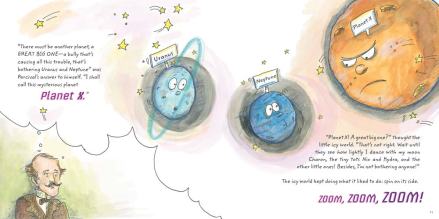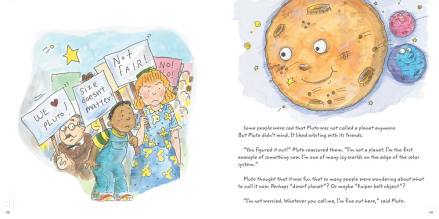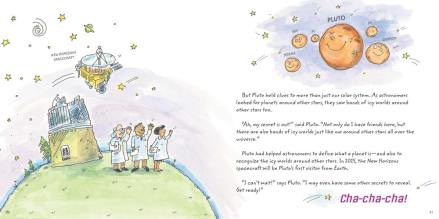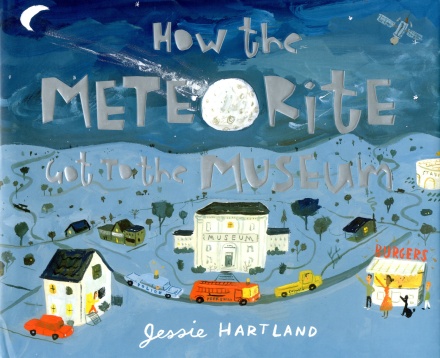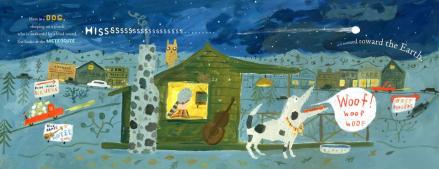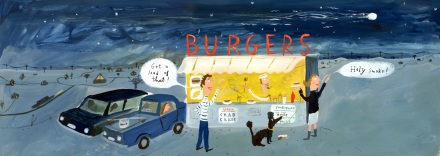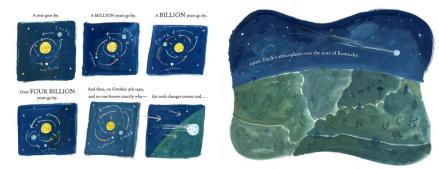About the Holiday
Today’s holiday commemorates a most auspicious moment in history that never happened! On March 23, 1989 a huge asteroid missed hitting Earth by only 500,000 miles. Did you feel the breeze as it blew by? Yeah, me too! I think we can all remember exactly where we were when we happily escaped suffering the same fate as the dinosaurs. So drink a toast to serendipity and the gravity of natural forces.
Oh No, Astro!
Written by Matt Roeser | Illustrated by Brad Woodard
Astro was not a typical asteroid. Instead of zooming around crashing into obstacles, he believed in “personal outer space” and had for millions of years. One day when Astro spies an approaching satellite, he greets him cordially and lays down the rules: “please keep your distance” and “stay in your orbit.” But the satellite ignores him and comes closer and closer until…

Image copyright Brad Woodard, courtesy of Simon & Schuster
“‘Good gravity! You’ve struck me!” Astro exclaims. He’s just about to “point out to the satellite that it had done considerable damage to one of his favorite craters” when he discovers that he is spinning out of his orbit and out of control. How humiliating! The usually unflappable space rock suddenly finds himself hurtling past Mars. At the same time young astronomer, Nova, is “enjoying a quiet night of stargazing” through her telescope. She catches sight of Astro as he zips past an astronaut, rushes past the Moon, and finds himself on an inevitable collision course with Earth.
As he enters Earth’s atmosphere he begins to break apart, shedding bits of the past, as the universe watches. He lands on Earth with a SMASH! Reeling from the impact Astro slowly opens one eye and then the other. He finds that he’s smaller but in one piece. Standing by is Nova, waiting to welcome him to his new home. “‘My stars,’” he mutters. “‘Dare I say that was…FUN?!’”
And as Astro gazes at the night sky from a fresh perspective with Nova by his side, he asks, “‘What on Earth shall we do next?!’”

Image copyright Brad Woodard, courtesy of Simon & Schuster
For anyone stuck in the rut of their own orbit, Matt Roeser’s story of the unwitting space traveler is a humorous invitation to explore the universe around them. Roeser’s language—from calling asteroids “rambunctious” and the satellite a “celestial wanderer” to exclamations of “good gravity!” and “Pluto’s revenge!”—is an inspired treat. Kids and adults will laugh at Astro’s attempts to handle his undesirable predicament with dignity. Complacent Astro with his dry-as-space-dust wit and sparkling puns makes a stellar guide on this journey to more self-discovery and life enjoyment.
In the hands of Brad Woodard, deep space is a very cute and cool place! Rendered in flat tones of black, aqua, yellow, red, and white, Woodard’s illustrations give Oh No, Astro! a retro feel for a space-savvy audience. The oblivious satellite floats through Astro’s orbit with wide eyes and a sweet grin, while angular Astro with his stick arms, expressive face, and boldly displayed “No loitering” banner would be a welcome alien intruder in any back yard. Inquisitive and inclusive Nova, in her ponytails and Saturn-patterned dress, is the perfect companion to greet him! The night sky abounds with constellations, but Astro is the real star!
In the final pages, Astro leads readers in a “A Selection of Space Facts” from the very Manual of the Cosmos, 2nd edition that he used to sort things out in his own life. A short list of suggested reading is also included.
Kids would love to find Oh No, Astro! on their bookshelf for story times of cosmic fun!
Ages 4 – 8
Simon & Schuster Books for Young Readers, 2016 | ISBN 978-1481439763
Visit Matt Roeser’s Website to discover his gallery of book jacket designs!
You can learn more about design and illustration work by Brad Woodard at Brave the Woods!
Near Miss Day Activity

Name That Asteroid! Word Search
Can you find the names of 20 asteroids floating around in this printable Name That Asteroid! Word Search Puzzle? Here’s the Solution!
Picture Book Review




